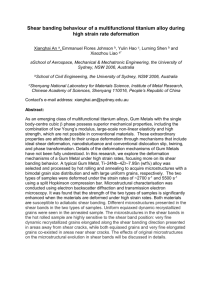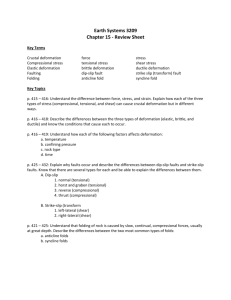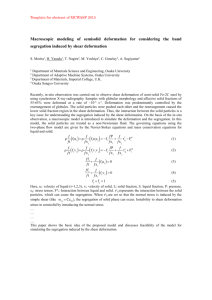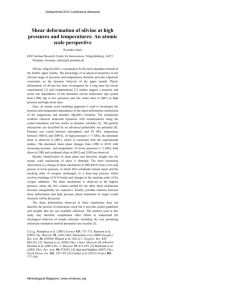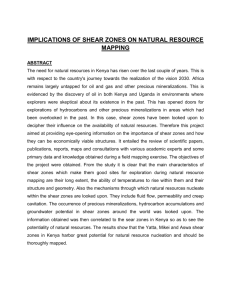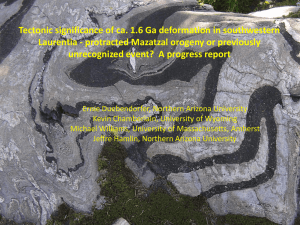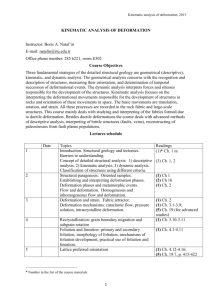The spatial extent and characteristics of block fields in Alpine areas
advertisement
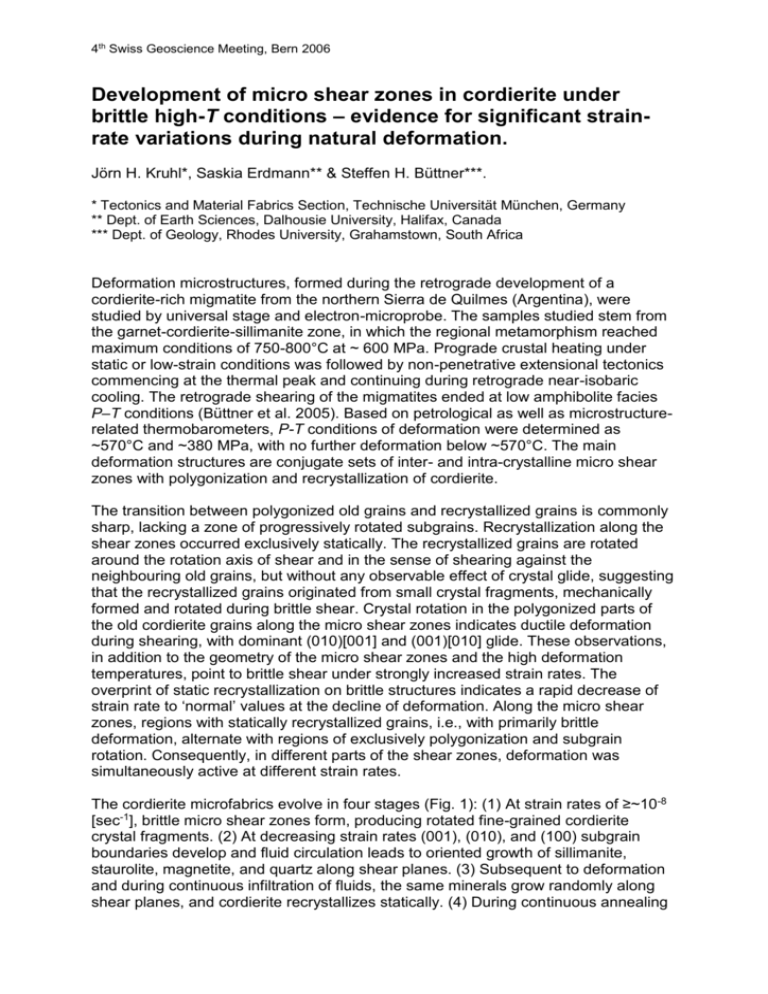
4th Swiss Geoscience Meeting, Bern 2006 Development of micro shear zones in cordierite under brittle high-T conditions – evidence for significant strainrate variations during natural deformation. Jörn H. Kruhl*, Saskia Erdmann** & Steffen H. Büttner***. * Tectonics and Material Fabrics Section, Technische Universität München, Germany ** Dept. of Earth Sciences, Dalhousie University, Halifax, Canada *** Dept. of Geology, Rhodes University, Grahamstown, South Africa Deformation microstructures, formed during the retrograde development of a cordierite-rich migmatite from the northern Sierra de Quilmes (Argentina), were studied by universal stage and electron-microprobe. The samples studied stem from the garnet-cordierite-sillimanite zone, in which the regional metamorphism reached maximum conditions of 750-800°C at ~ 600 MPa. Prograde crustal heating under static or low-strain conditions was followed by non-penetrative extensional tectonics commencing at the thermal peak and continuing during retrograde near-isobaric cooling. The retrograde shearing of the migmatites ended at low amphibolite facies P–T conditions (Büttner et al. 2005). Based on petrological as well as microstructurerelated thermobarometers, P-T conditions of deformation were determined as ~570°C and ~380 MPa, with no further deformation below ~570°C. The main deformation structures are conjugate sets of inter- and intra-crystalline micro shear zones with polygonization and recrystallization of cordierite. The transition between polygonized old grains and recrystallized grains is commonly sharp, lacking a zone of progressively rotated subgrains. Recrystallization along the shear zones occurred exclusively statically. The recrystallized grains are rotated around the rotation axis of shear and in the sense of shearing against the neighbouring old grains, but without any observable effect of crystal glide, suggesting that the recrystallized grains originated from small crystal fragments, mechanically formed and rotated during brittle shear. Crystal rotation in the polygonized parts of the old cordierite grains along the micro shear zones indicates ductile deformation during shearing, with dominant (010)[001] and (001)[010] glide. These observations, in addition to the geometry of the micro shear zones and the high deformation temperatures, point to brittle shear under strongly increased strain rates. The overprint of static recrystallization on brittle structures indicates a rapid decrease of strain rate to ‘normal’ values at the decline of deformation. Along the micro shear zones, regions with statically recrystallized grains, i.e., with primarily brittle deformation, alternate with regions of exclusively polygonization and subgrain rotation. Consequently, in different parts of the shear zones, deformation was simultaneously active at different strain rates. The cordierite microfabrics evolve in four stages (Fig. 1): (1) At strain rates of ≥~10-8 [sec-1], brittle micro shear zones form, producing rotated fine-grained cordierite crystal fragments. (2) At decreasing strain rates (001), (010), and (100) subgrain boundaries develop and fluid circulation leads to oriented growth of sillimanite, staurolite, magnetite, and quartz along shear planes. (3) Subsequent to deformation and during continuous infiltration of fluids, the same minerals grow randomly along shear planes, and cordierite recrystallizes statically. (4) During continuous annealing 4th Swiss Geoscience Meeting, Bern 2006 and fluid infiltration, the recrystallized cordierite grains coarsen, and sillimanite, staurolite, magnetite, and quartz form along the grain boundaries. Given that quartz in the studied sample also shows brittle and ductile deformation textures related to the ~570°C deformation event, we infer a minimum strain-rate increase and subsequent decrease of six orders of magnitude, using the strain-rate and temperature dependent brittle-ductile transition of quartz, determined in experiments and nature. This strain-rate variation is regarded as indication of a paleo-seismic event. The formation of statically recrystallized grains of rock-forming minerals, mainly quartz and feldspars, over brittle microstructures, mainly microfractures, is a common phenomenon in naturally deformed rocks. Therefore, it appears possible to receive detailed information on wide-spread paleo-seismic events. In addition, micro shear zones as described may give information about the orientations of the related stress fields and, based on the different fields of plasticity of different rock-forming minerals, more detailed information on strain-rate variations during natural rock deformation. Figure 1. Model for the development of the studied micro shear zones in cordierite and related microfabrics. The schematic sketches illustrate four stages of different deformation, strain rate, and fluid infiltration/reaction conditions (from Kruhl et al.). REFERENCES Büttner, S.H., Glodny, J., Lucassen, F., Wemmer, K., Erdmann, S., Handler, R. & Franz, G. (2005): Ordivician metamorphism and plutonism in the Sierra de Quilmes metamorphic complex: implications for the tectonic setting of the northern Sierras Pampeanas (NW Argentina). Lithos 83: 143-181. 4th Swiss Geoscience Meeting, Bern 2006 Kruhl, J.H., Erdmann, S. & Büttner, S.H.: Brittle-ductile microfabrics in naturally deformed cordierite: evidence for significant short-term strain-rate variations. Journal of Structural Geology (under revision).
